The plan was to catch a train to Breda, from where we would pick up an Amsterdam-Brussels train that would stop at Antwerp. Boarding the Antwerp bound train at Breda was a whole new commute experience. To call it crowded would be an underestimate. The majority of folk on board were young people, probably all students traveling between the large university cities that lie on this train route, and most in comatose states. Distributed amongst the young crowd were groups of people of multiple nationalities: strewn across seats, snoring, feet up, eating, belching, farting and creating a toxic environment. All in all, a good cross section of society.
All good things come to an end, and our train ground to a halt in Antwerp Central station. This grand affair truly enables the Grand Entry into Antwerp, and arguably the architecturally most outstanding construction of its kind in Flanders and Belgium. Dubbed the "Railway Cathedral", it is one of the main landmarks in Antwerp. The station was built at the end of the 19th century (1895-1905) and replaced an earlier station of the Brussels-Mechelen-Antwerp railway. The monumental main building was designed by the Bruges architect L. Delacenserie. The railway station was topped by an impressive dome. Another distinguishing feature of the station was the large iron and glass train shed, which after renovation had been painted in red on the outside. The huge glass vault was designed by the architect J. Van Asperen. The original platform and tracks themselves were elevated; the two lower levels were added later to accommodate the high-speed train connection to Amsterdam. Besides the platforms, the vault also covered many of the small diamond and gold shops, which were part of the diamond district next to the Central Station. The colourful interior was lavishly decorated with more than 20 different kinds of marble and stone. The main hall and the railway cafeteria could match the interiors of many palaces. Not a single square meter either inside or outside the building was not decorated.
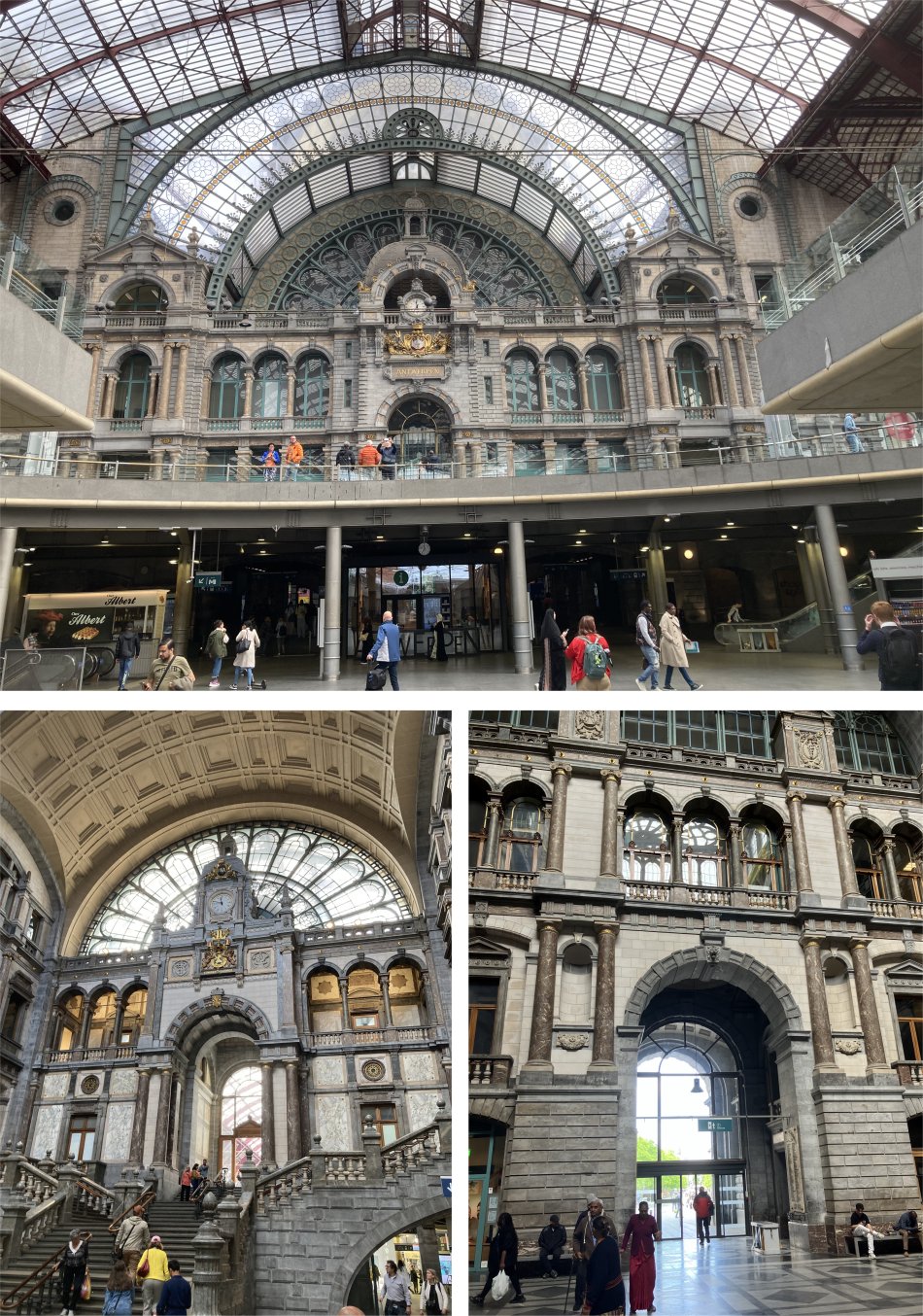 Antwerp Central Station |
"Wow, people are normally here for only three hours," he responded.
He then outlined a rough plan that would take us through the city, visiting the small, older section, and eventually bring us to Het Steen by the Schelde. We thanked the chap, who was still thrilled to see us, and armed with a map he had marked up for us, headed on our journey of discovery.
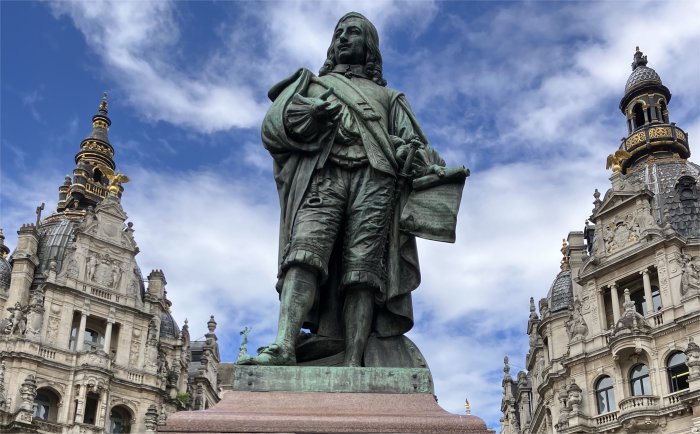 David Teniers the Younger - Painter and Printmaker |
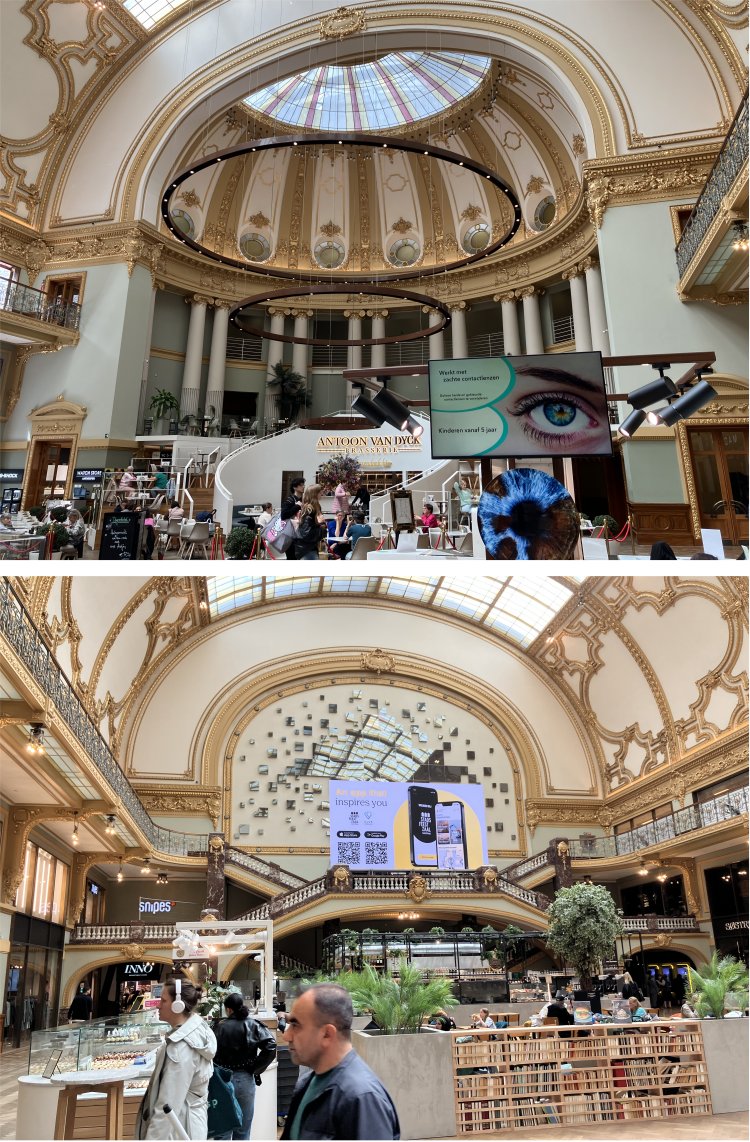 Stadsfeestzaal |
We headed along Keyserlei towards the Meir, the shopping high-street of Antwerp, beyond which lay the historic heart of the city. At the beginning of Meir stood what appeared to be just another apartment store, the Stadsfeestzaal.
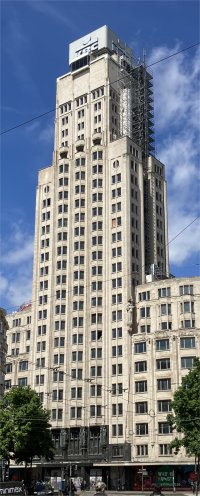 Boerentoren - or KBC Tower |
Rex was heavily distracted by the tantalising glitz and glamour of all the huge variety of shops along Meir. He drooled and dribbled at the windows, an embarrassing sight to behold, and I had to drag him out of a few of the stores on several occasions.
But kicking and screaming, I managed to drag him to the bottom of Meir, where we were confronted by the Boerentoren, (Farmers' Tower), officially the KBC Tower, reputed to be the first skyscraper on the European continent. Constructed between 1929 and 1932 and originally 87.5m high, it remained the tallest building and the second-tallest structure in the city (after the Gothic Cathedral of Our Lady). Hmm …. This does not sit easy on my mind. In our travels in Rotterdam, we have come across the Witte Huis, (White House), built in 1898 in the Art Nouveau style. The building is 43m tall, and was described as the first high-rise building in Europe. So, out of the two, which one can call itself the first skyscraper? Depends on the definition in those times of 'skyscaper'.
Rather than head straight ahead into the older part of the city, we made a detour to the right , up Sint-Katelijnevest to Hendrik Conscienceplein. The square, sometimes referred to as the Jesuit Square, has been named after 19th-century Flemish writer Hendrik Conscience.
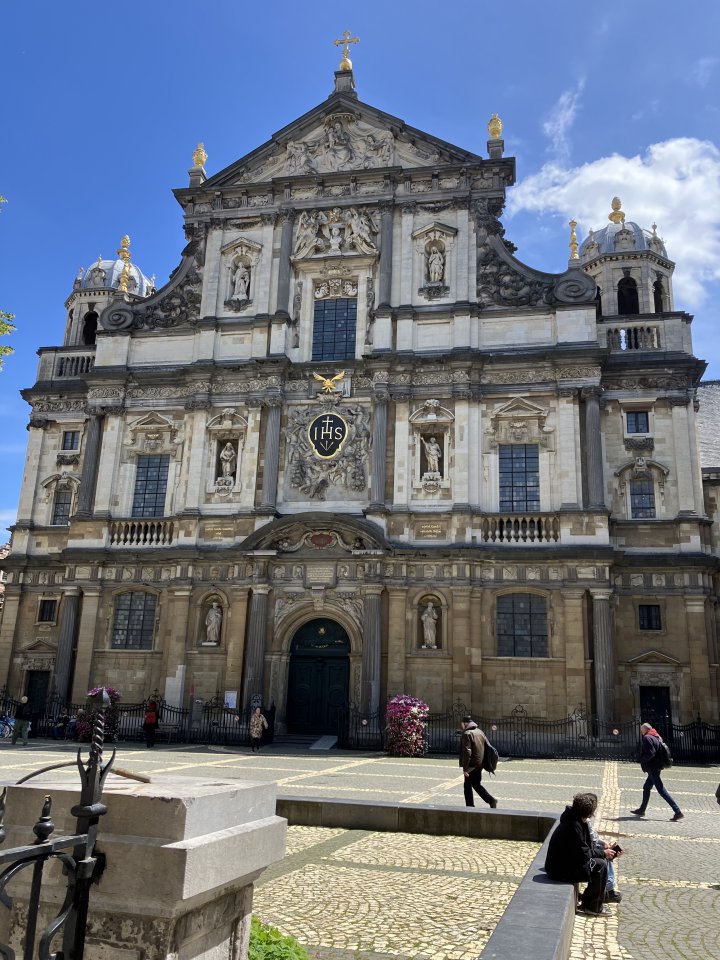 St. Carolus Borromeus Church |
The partly 17th-century buildings around the square are characterized by a baroque style. This is especially true for the imposing St. Carolus Borromeus Church, a former Jesuit church. The baroque style of the buildings around the square, with a lot of pomp and circumstance, was deliberately stimulated by the Jesuits: as part of the Counter-Reformation order who wanted to stimulate the population to come to the churches in all kinds of ways.
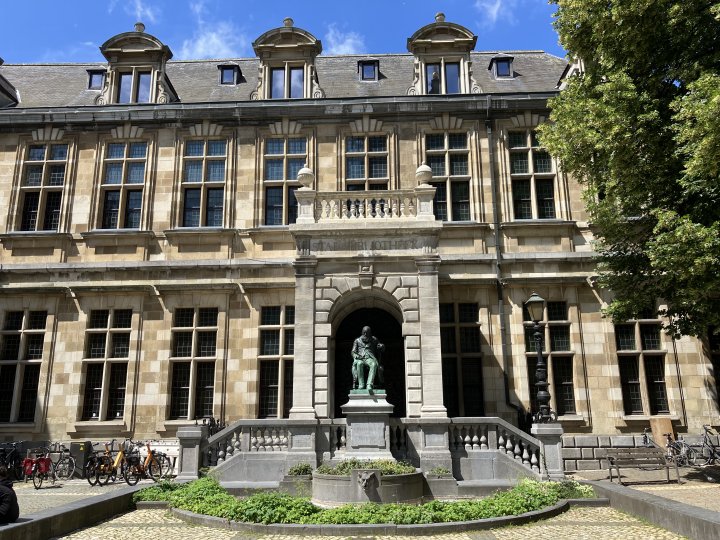 Sodality House with statue of Hendrik Conscience |
Opposite the St. Carolus Borromeus Church, the Jesuits built their Sodality House in the 17th century. Sodalities were associations of pious citizens. When the premises in the city hall became too small for the library, the books were moved to the Sodality; the Jesuits had long since left by then. The new library opened in 1883 with a public celebration. The statue of Hendrik Conscience was inaugurated at the same time. In 1936 and 1996 new wings were added to the library. The result is the Hendrik Conscience Heritage Library, the heritage library of the city of Antwerp. The collection today counts more than 1.5 million volumes. Sadly the library could only be visited during exhibitions and attractions.
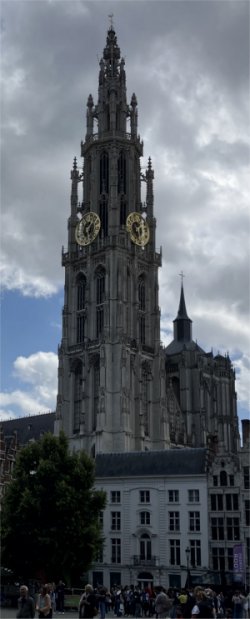 Onze-Lieve-Vrouwekathedral |
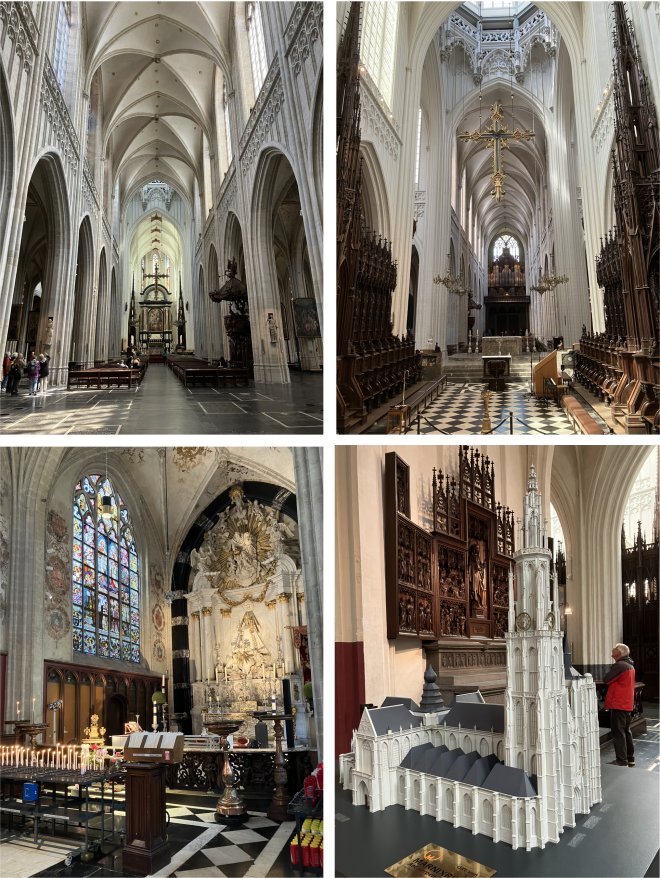 Inside Onze-Lieve-Vrouwekathedral |
A cultural highlight in this history is Pieter Paul Rubens, the grand master of Baroque painting. The Antwerp Cathedral houses four of his masterpieces, including Descent from the Cross (1612)), Elevation of the Cross (1610) and the Resurrection Triptych (1612). Less known, but no less interesting is the epitaph for Jan Moretus and Martina Plantin. A radiant Christ rises from his grave. In the central axis of the church building is the Assumption of Mary. Re-allocated between 1609 and 1627, the four paintings beautifully depict the artistic development of the Antwerp master. Moreover, this collection is surrounded by paintings from important forerunners such as Maarten De Vos and Otto Venius and followers such as Cornelius Schut, who made the round painting in the beautiful celebration tower.
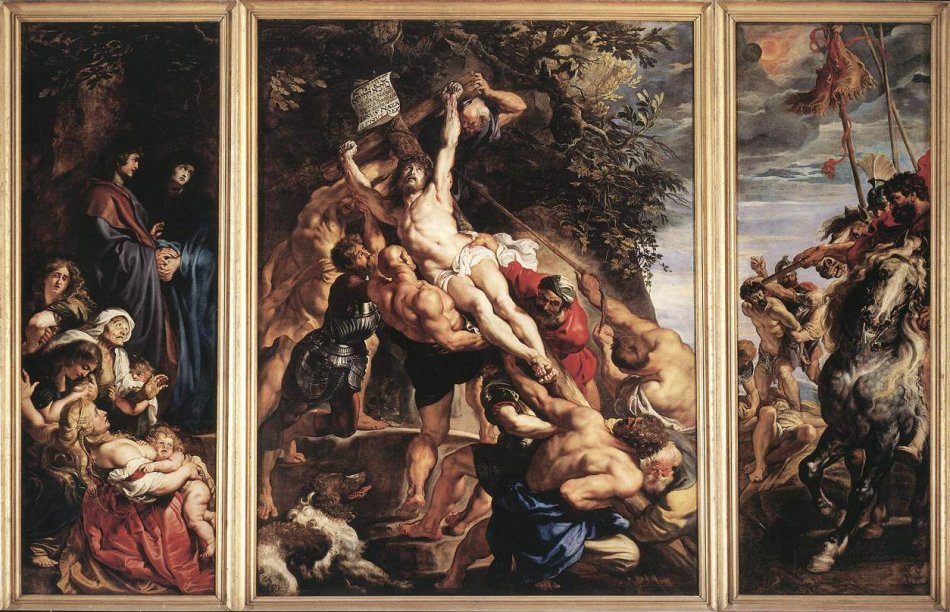 Elevation of the Cross (1610) - Rubens |
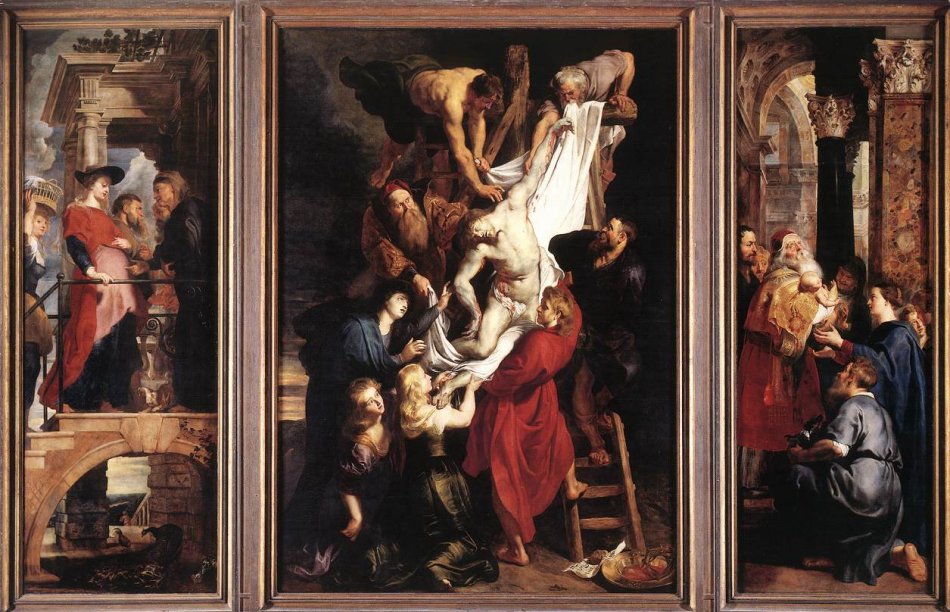 Descent from the Cross (1612) - Rubens |
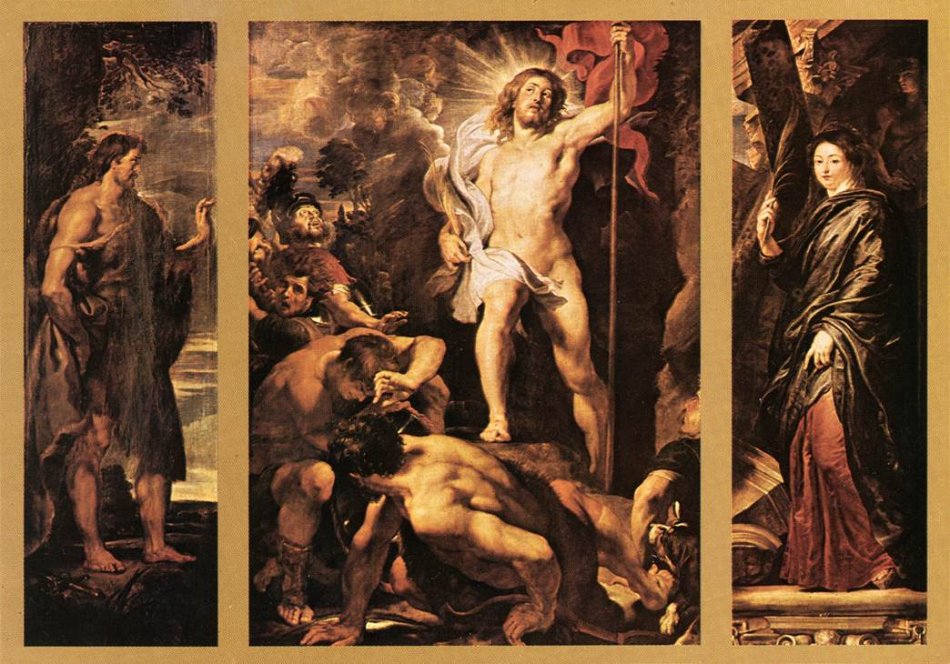 Resurrection of Christ (1612) - Rubens |
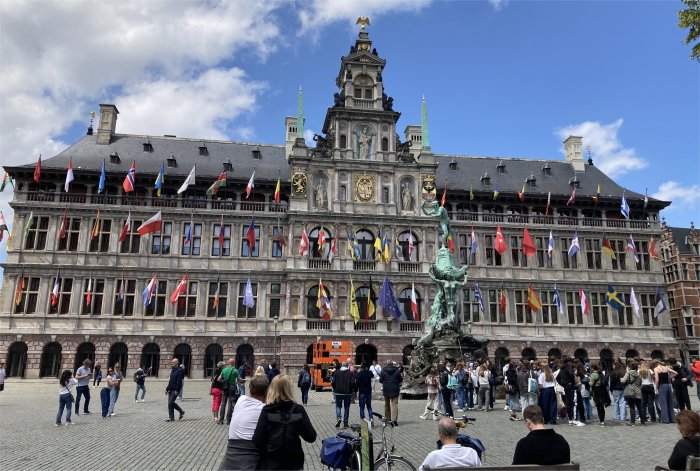 Stadhuis with Statue of Brabo Before It |
Behind it, decked out in colourful flags, the Stadhuis (Town Hall) took a commanding position over the Grote Markt. Replacing an older smaller building, the present Stadhuis of Antwerp was built by Cornelis Floris de Vriendt between 1561 and 1565 in Renaissance style, with a touch of Flemish Gothic so as not to contrast too sharply with the surrounding buildings. It needed rebuilding a few years later after being destroyed during the Spanish Fury of 1576. The richly ornamented centre section rose above the eaves in diminishing stages with the statue of the Virgin adorning the central gable. Below stood other statues representing Justice and Prudence, together with the coats of arms of the Duchy of Brabant, the Spanish Habsburgs, and the Margraviate of Antwerp.
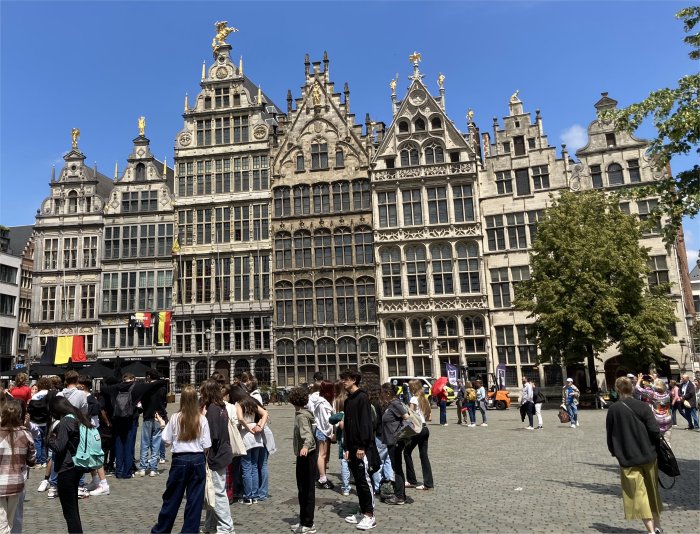 Gildehuizen |
We took time out to enjoy a coffee at Den Engel (the angel), perched on the end of the string of guild houses. The history of café goes back to the 14th century. In that century the building was already known as "Den Engel". In the 15th century, the building, like almost all houses on the Grote Markt, became the property of merchants. In 1465, for example, it was in the possession of Bruges merchant Francois Gheraerts. He in turn sold it to Thielman Palm. The building has passed through various hands over the years; Peter Oeyls, Francois Lycoops, Lenaert van Uffel… until a drugstore was found in 1740. You can still find a reference to the drugstore on the facade of the café. After a varied history, Frans De Cat-Laureys opened the existing café “Den Engel” here in 1902.
Endless convoys of guided groups and smaller groups drifted across the square, and for many, digital imprints stored on specs of semiconductors, stored in their handheld devices, would be the only memory they'd have of the event. We seemed to have chosen a café where many locals, a lot of them our age, congregated to exchange news, stories and memories with each other. This haven was a little oasis.
Basking in that rare novelty of a dry day with predominantly sunny intervals, we had a chance to reflect on the history of the city.
Antwerp is located on the river Schelde, which is linked to the North Sea by the Westerschelde estuary. The city is Belgium's second city and biggest port, in fact it is the second largest harbour of Europe (after Rotterdam). One third of all Belgian exports transit through the Flemish city. Antwerp is also the world's second petrochemical port, after Houston in the USA. Half of the world's top 20 chemical companies have offices in Antwerp.
According to folklore, the city got its name from a legend involving a mythical giant called Antigoon who lived near the river Schelde. He exacted a toll from those crossing the river, and for those who refused, he severed one of their hands and threw it into the river Schelde. Eventually, the giant was slain by a young hero named Brabo, who cut off the giant's own hand and flung it into the river. Hence the name Antwerpen, from Dutch hand werpen, or throw a hand.
As far back as the 2nd and 3rd century A.D during the Roman era, humans resided in the vicinity on the banks of the river Schelde. Excavations show that the site was inhabited again during 650 when Christianity arrived in Europe. Later on, that friendly bunch, the Vikings, attacked the settlement in 836 forcing the inhabitants to migrate to "aanwerp", an alluvial mound, where later the Steen castle was built.
After the decline of Bruges due to silting up of the Zwin, the city of Antwerp, part of the Duchy of Brabant and controlled from Brussels, gained in importance. Foreign trading houses transferred from Bruges to Antwerp at the end of the 15th century. Antwerp reputedly became the richest city in Europe. In the Golden era of 16th century, the city started maturing as the most economic and cultural hub in the world. Antwerp started importing sugar from Portuguese and Spanish plantations, and became the sugar capital of Europe. The city attracted Italian and German sugar refiners by 1550, and shipped their refined product to Germany, especially Cologne. Booms were also established in pepper, American silver via Seville and textiles. Moneylenders and financiers operated a large business loaning money to the English government in the 1544-1574 period. London bankers were too small to operate on that scale, and Antwerp had a highly efficient bourse that itself attracted rich bankers from around Europe. Many foreign merchants were resident in the city. The economy of Antwerp was controlled by foreigners, making the city very cosmopolitan, with merchants and traders from Venice, Ragusa, Spain and Portugal. Antwerp had a policy of toleration, which attracted a large orthodox Jewish community. After the 1570s the city's banking business declined; England ended its borrowing in Antwerp in 1574.
During the Eighty Years' War, in 1576, the city was plundered by Spanish soldiers, who massacred about 6,000 of its citizens during the so-called Spanish Fury. Antwerp was captured again by the Spanish in 1585, but they allowed protestant citizens to leave, often northwards to the present-day Netherlands. Antwerp declined, and soon thereafter the United Provinces of the North experienced their golden age. The city further declined for centuries and after the Treaty of Munster (end of the Eighty Years' War), the Schelde river was actually closed to navigation. The harbour was revived again during Napoleonic times in the belief that by making Antwerp's harbour the finest in Europe, France would be able to counter London's harbour and stint British growth. The Battle of Waterloo put an end to that plan though.
After the defeat at Liège during World War I, the city became the fall-back point of the Belgian Army. The resulting Siege of Antwerp lasted for 11 days, but the city was taken after heavy fighting, and the Belgians were forced to retreat westwards. Antwerp remained under German occupation until the Armistice. During World War II, the city was an important strategic target because of its port. It was occupied by Germany in May 1940 and liberated by the British 11th Armoured Division on 4th September 1944. The Germans then attempted to destroy the Port of Antwerp, which was used by the Allies to bring new material ashore. Thousands of Rheinbote, V-1 and V-2 missiles battered the city. As a result, the city itself was severely damaged and rebuilt after the war in a modern style. After the war, Antwerp, which had already had a sizeable Jewish population before the war, once again became a major European centre of Haredi Orthodox Judaism.
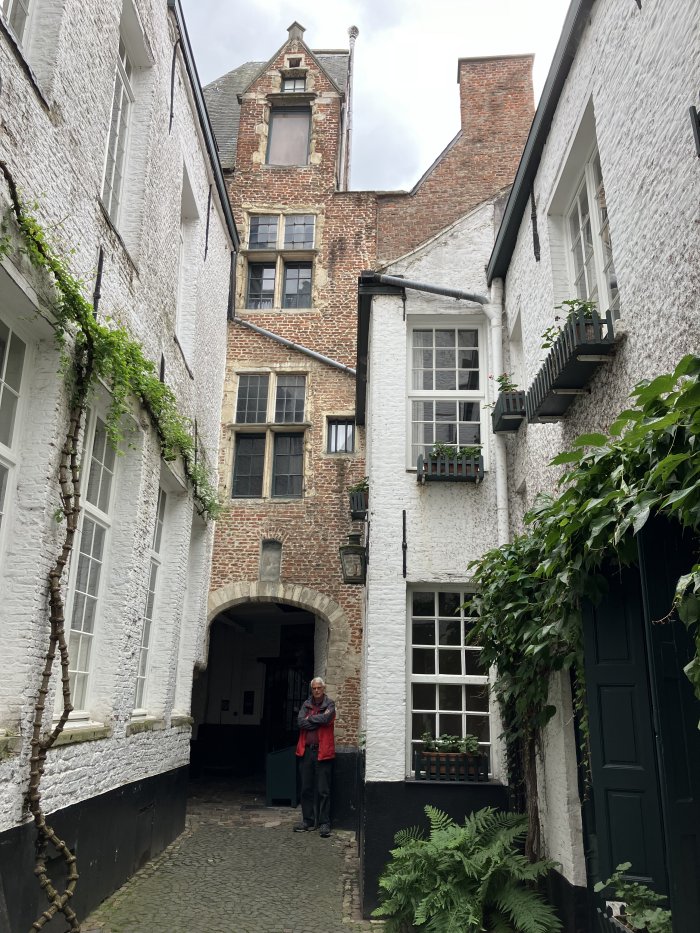 Vlaaikensgang |
We were particularly keen to visit the Oude Koornmarkt. The street runs from the Grote Markt to the Kammenstraat and is known for its numerous restaurants and cafes. It owes its name to the weekly grain markets that were held here until the 15th century. The breweries were nearby in the Kammenstraat. In the 16th century, the grain market moved to the "Brabant Korenmarkt".
What we really wanted to see was the Vlaaikensgang, which lay in a side alley reached by stepping through the gate at 16 Oude Koornmarkt. The alley is so short that the end is reached before you know it. The Vlaaikensgang dates back to the year 1591. The city's poorest people used to live here, along with the cobblers who were tasked to ring the emergency bell of the nearby cathedral. There were plans to demolish this medieval street in the 1960s and replace it with a parking lot, until antique dealer Axel Vervoordt bought the Vlaaikensgang and had it restored. Thanks to him, this alley is still an oasis of calm. The historic alley contains cobblestone paths with a total of eleven authentic houses that are mainly made of brick and sandstone, some of which have whitewashed facades - a real walk back in time.
Today you will find antique shops, art galleries and some restaurants in the Vlaaikensgang. The classic restaurant, Sir Anthony van Dyck, with a beautiful Renaissance interior and fireplace, fits perfectly into this alley. The restaurant 't Hofke also breathes a cozy old-fashioned atmosphere. In addition to a beautiful setting for an intimate dinner, the Vlaaikensgang is also a popular place to come and listen to the summer carillon concerts. Sadly, Rex and I had to decline invitations to dine here; our attire wasn't up to the mark.
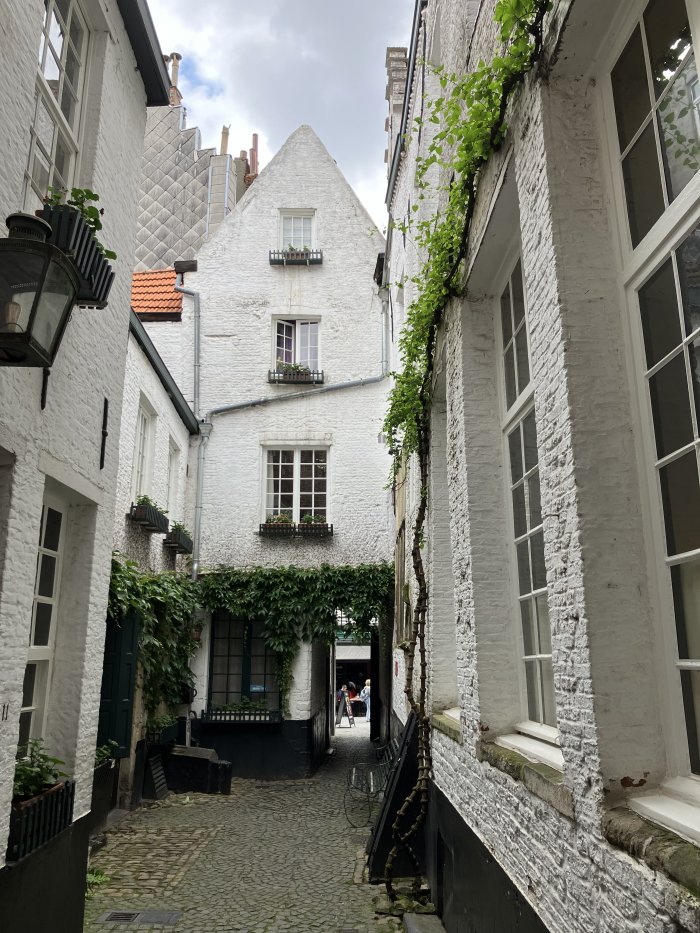 Vlaaikensgang |
The Schelde estuary had always been of considerable commercial and strategic importance, and the Schelde once formed the border between France and the Holy Roman Empire. Under Spanish control in 1585, the Dutch Republic took control of Zeeuws-Vlaanderen, a strip of land on the left shore, and closed the Schelde for shipping. This shifted the trade to the ports of Amsterdam and Middelburg and seriously crippled Antwerp. The river was reopened in 1792 during the French Revolutionary era. In World War II the estuary once again became a contested area. Despite allied control of Antwerp, in September 1944 German forces still occupied fortified positions throughout the Schelde estuary west and north, preventing any allied shipping to the port. In the Battle of the Scheldt, the Canadian First Army successfully cleared the area, allowing supply convoys direct access to the port of Antwerp by November 1944.
Those tempestuous times had long been washed away, and now the river slowly and peacefully flowed down to the estuary to meet its destiny in the North Sea.
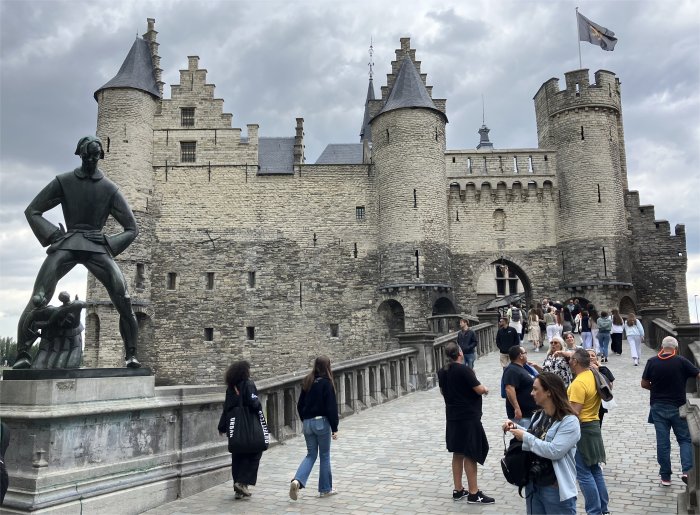 Het Steen |
When we visited Antwerp ten years earlier, neither of us visited Het Steen: Rex accompanied Meryl to the fashion museum while I visited Rubenshuis, so, this was our opportunity.
Inside we followed the Antwerp Story . This is a multimedia trail in 11 rooms with an exhibition about the rich history and identity of the city, getting to know the districts, the museums and the famous Antwerp residents. At times it was like looking through a window at city life from the sixteenth century. There were variations such as immersing yourself in a 360° projection that guides you through the port of Antwerp.
Art, diamond cutters and other creative professions are constantly innovating, just like the city, and were highlighted in specific rooms. In the holographic fashion studio, you can even see designer Sander Bos live at work.
On the roof of Het Steen was the panoramic roof terrace, which afforded a phenomenal view of the city, the port and the wide Schelde river with a cruise terminal below us, the massive dock complex further downstream, and a marina partially hidden on the opposite bank.
We were now reaching information overload. Taking our leave of this lovely city, we made our way back to Dordrecht. Amazingly the sun shone, so we ate and drank outside for a change.
It had been a lovely day.

